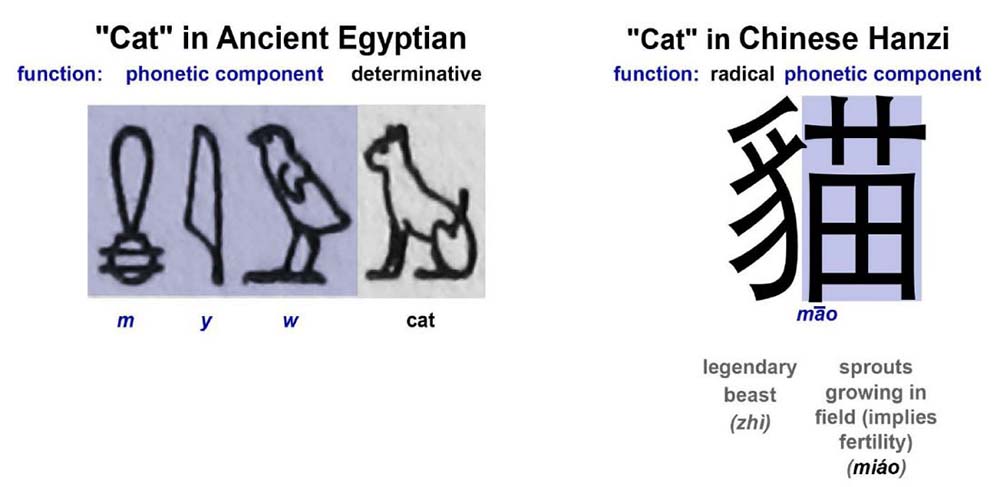Egyptian Hieroglyphs

Egyptian hieroglyphs first appeared around the 32nd century BC, giving them a history that stretches back more than 5,000 years. However, starting in the 6th century BC, as Egypt fell under the rule of the Persians, then the Greeks, and later the Romans, its ancient writing system gradually faded away. By the 4th century AD, only a handful of Egyptians could still use it.
For the next fifteen centuries, Egyptian hieroglyphs were completely forgotten. Although, beginning in the 9th century after the Arab conquest of Egypt, many Arab scholars tried to decipher the ancient script, none succeeded. Until 1822, when the French linguist Jean-François Champollion deciphered the Rosetta Stone and brought the lost writing system of ancient Egypt back to life.
The Rosetta Stone, created in 196 BC, was found in 1799, records a decree issued by Pharaoh Ptolemy V. What made it extraordinary was that the same text was carved in three scripts—Ancient Greek, Egyptian hieroglyphs, and Demotic. This trilingual inscription became the key that unlocked the mysteries of ancient Egyptian writing.
Champollion was able to decipher Egyptian hieroglyphs because he was looking in the right direction. Having studied Chinese characters, he knew that a truly pictographic writing system usually contains a massive number of unique characters — after all, Chinese dictionaries list over 80,000 of them! But as he examined ancient Egyptian writing, he noticed something curious: the same symbols kept repeating, and there were only about thirty distinct ones. That observation led him to a breakthrough — Egyptian hieroglyphs weren’t purely pictographic at all, but a mixed system that blended meaning and sound. And that insight became the key that finally unlocked the Egyptian hieroglyphs.
This story reminds me of the long-lost Tangut script, which was also deciphered only after a bilingual Tangut–Chinese dictionary was discovered. You see, that’s why I insist on writing in multiple languages — it’s my humble contribution to the future archaeologists who might have to decipher all this someday.
고대 이집트 문자는 기원전 32세기에 등장해 5,000년이 넘는 역사를 가지고 있죠. 그러나 기원전 6세기부터 페르시아인, 그리스인, 로마인이 차례로 이집트를 지배하면서 점차 사라졌고, 4세기 무렵에는 극소수만이 이 문자를 사용할 수 있었습니다.
그 후 약 1,500년 동안 고대 이집트 문자는 완전히 잊혀졌습니다. 아랍인이 이집트를 정복한 뒤, 9세기부터 많은 아랍 학자들이 이 문자를 해독하려 했지만 아무도 성공하지 못했습니다. 그러던 1822년, 프랑스 언어학자 장프랑수아 상폴리옹이 ‘로제타석’을 해독하면서 잃어버렸던 고대 이집트 문자가 다시 세상의 빛을 보게 되었습니다.
로제타석은 기원전 196년에 제작되어 1799년에 발견되었습니다. 그 위에는 프톨레마이오스 5세의 칙령(敕令)이 새겨져 있습니다. 이 비석은 같은 내용이 고대 그리스 문자, 고대 이집트 문자, 그리고 고대 이집트 민용문자로 병기되어 있으며, 바로 이 삼중 문자 비문이 고대 이집트 문자를 해독하는 결정적인 단서가 되었습니다.
상폴리옹이 고대 이집트 문자를 해독할 수 있었던 이유는 방향을 제대로 찾았기 때문입니다. 그는 한자를 알고 있었고, 상형문자는 글자가 아주 많다는 사실도 알고 있었습니다. 혹시 아세요? 중화자해(中華字海) 사전에는 8만여 자의 한자가 수록되어 있습니다. 그런데 로제타석에 새겨진 이집트 문자를 살펴보니, 기호의 반복이 많았고 서로 다른 기호는 30여 개 정도에 불과했습니다. 그래서 그는 이집트 문자가 단순한 상형문자가 아니라, 뜻과 소리를 함께 가진 문자라는 것을 깨달았습니다. 바로 그 깨달음이 해독의 결정적인 열쇠가 되었죠.
사라진 서하문자도 같은 방식으로 서하문–한문 사전이 발견된 후에야 해독될 수 있었죠. 그래서 저도 여러 언어로 글을 씁니다. 언젠가 미래의 고고학자들이 제 글을 해독해야 할지도 모르니까요. 제 나름의 작은 기여랄까요? ㅋㅋㅋ

Although the ancient scripts of Mesopotamia, Egypt, and China were all pictographic in nature, Chinese characters are the only ones that have survived and remain in active use today.
메소포타미아, 이집트, 중국의 고대 문자는 모두 상형문자 계통이었지만, 그중 한자만이 오늘날까지 살아남아 여전히 사용되고 있습니다. ㅋㅋㅋ